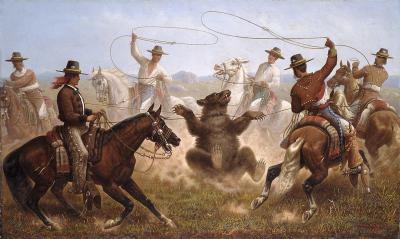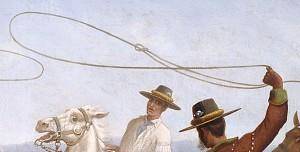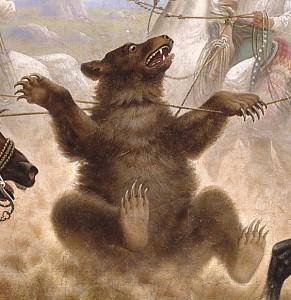
Cowboys Roping a Bear
James Walker, United States
About 1877
29.3 in. x 49.3 in.
Fred E. Gates Fund, 1955.87
Photograph © Denver Art Museum 2009. All Rights Reserved.
James Walker was born in England in 1818 and moved to New York with his parents when he was a child. He lived in New York for most of his life, traveling frequently in the United States and to Mexico. He was living in Mexico City in 1846 when the Mexican War broke out. He was forced into hiding for six weeks before being able to get behind United States lines. In addition to painting scenes of the war, he was fluent in Spanish and served as an interpreter for United States troops. In the 1870s, he moved to California and was captivated by California’s romantic Mexican past. He established a studio in San Francisco, where this painting was probably made.
After moving to California, Walker often visited the ranches of his Spanish-speaking friends. This painting was probably made after a trip to a ranch near San Diego. During his visits, Walker became fascinated with the life and culture of the vaqueros [vah-CARE-ohs]—the Spanish cow and ranch hands. In this painting, the men are not roping the bear merely for amusement. In the early 1800s, grizzly bears were one of the biggest threats to cattle. While the Anglo-American style was to use heavy artillery to control threatening bears, the vaqueros preferred to rope them from the back of a well-trained horse. This method of bear control required a great deal of skill and was a dying vaquero art.
Details

Vaquero Attire
Vaqueros outfitted themselves in dashing yet functional dress, and Walker shows all the details:
- Wide-brimmed hats with flat tops gave protection from the sun.
- Thin leather jackets, similar to today’s jean jackets, were often decorated with silver. They were tough yet light and protected against thorns and bug bites.
- Leather pants had buttons down the legs that could be buttoned or unbuttoned according to the weather.
- Botas [BOW-tahz], leather leg wraps, were worn for extra protection against cactuses and snakes.
- Colorful woven blankets, called serapes [sehr-AH-pehs], were rolled up and carried behind the saddles.

Ropes
Most vaqueros made their own reatas [ray-AH-tahs], or ropes, by braiding four to eight strands of rawhide together. Most reatas were about 60 feet long.

The Lasso
The lasso is a long rope with a loop at one end that, once the rope has been accurately thrown, tightens securely around the target. It was a tricky maneuver—a vaquero used a special technique to toss the rope and quickly drape one end of it around the saddle horn, or handgrip. If he did not drape the rope around the saddle horn before the animal pulled the rope taut, the vaquero could injure a hand, even losing a finger or two between the rope and saddle horn.

The Bear
At one time California supported the greatest number of grizzly bears in North America, but they became locally extinct by 1908. The decline of the California grizzly began during the Spanish Colonial period. At first, the bear population increased as free-ranging cattle provided an easy food source, but their numbers dropped with the increase in human settlement and the killing of grizzlies by cattlemen. Grizzlies were often captured for sport by vaqueros using only horses and ropes.

Mirror Images
Walker balanced the figures in this painting by pairing each rider’s pose with the rider opposite him. For example, the two vaqueros getting ready to throw their lassos are opposite each other in similar poses. Color is also mirrored, this time left and right, as seen in the two riders wearing white shirts on white horses.
More Resources
Web Resources
American Gallery
Explore this site to see more paintings done by James Walker.
The Autry National Center
Established in 2003, The Autry National Center celebrates the American West through three important institutions: the Museum of the American West, the Southwest Museum of the American Indian, and the Institute for the Study of the American West.
New Mexican Hispanic Culture Preservation League
This site provides information about vaqueros.
Books
Dryer, John. El Vaquero Real: The Original American Cowboy. Houston, Texas: Bright Sky Press, 2007.
A photographic biography of the vaquero.
Children's Books
Freedman, Russell. In the Days of the Vaqueros. Boston, MA: Sandpiper, 2008.
In this book, appropriate for ages 9-12, Freedman explores the often-overlooked role of the Central American cow herders who preceded by centuries the cowboys of popular lore and legend.
Funding for object education resources provided by a grant from the Morgridge Family Foundation. Additional funding provided by the William Randolph Hearst Endowment for Education Programs, and Xcel Energy Foundation. We thank our colleagues at the University of Denver Morgridge College of Education.
The images on this page are intended for classroom use only and may not be reproduced for other reasons without the permission of the Denver Art Museum. This object may not currently be on display at the museum.
